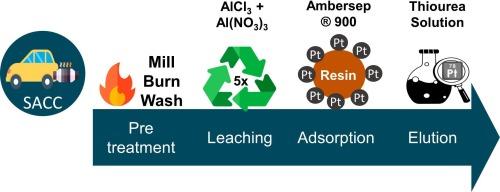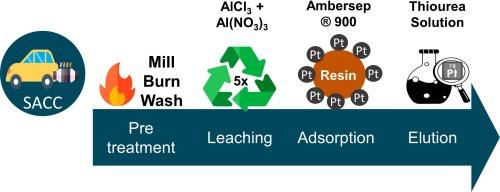用铝基盐溶液浸出回收废旧汽车催化转化器中的铂
IF 9
1区 工程技术
Q1 ENGINEERING, CHEMICAL
引用次数: 0
摘要
全球对金属需求的增加加剧了采矿活动,引起了严重的环境问题。铂族金属(PGM)被欧盟列为关键原材料(CRM),是现代工业,特别是汽车催化转化器的重要原料。从废旧汽车催化转化器(SACC)中回收PGM代表了一种可持续的循环经济战略,减少了对初级采矿的依赖。本研究开发了一种新的湿法冶金工艺,利用AlCl3·6H2O和Al(NO3)3·9H2O水溶液从SACC中回收PGM,这是一种更环保的替代苛刻的王水的方法。使用了一辆柴油车的真实SACC,对其进行了表征和预处理。表征证实Pt是其组成中唯一可测量的PGM。对浸出关键操作参数(试剂、固液比、温度、接触时间)进行优化,确定温度是浸出Pt的关键因素。在最佳浸出条件下,单步浸出效率高,浸出率达94% %。使用Ambersep 900®阴离子交换树脂实现Pt的选择性分离,然后用硫脲溶液洗脱Pt。该工艺成功地扩大了60倍,证明了浸出介质在5个循环中可重复使用而不损失效率,并实现了418 mg·L-1的Pt浓度。树脂对Pt的吸附率为97 %,解吸回收率为96 %,最终得到分离的Pt。初步的成本分析强调了这种无酸开采方法的经济可行性。本文章由计算机程序翻译,如有差异,请以英文原文为准。


Recovery of platinum from spent automotive catalytic converters by leaching with aluminium-based salts solutions
The increasing global demand for metals has intensified mining activities, raising serious environmental concerns. Platinum group metals (PGM), classified as critical raw materials (CRM) by the European Union, are essential to modern industries, particularly for automotive catalytic converters. Recycling PGM from spent automotive catalytic converters (SACC) represents a sustainable and circular economy strategy, reducing the dependence on primary mining. In this study, a new hydrometallurgical process was developed for PGM recovery from SACC using an aqueous solution of AlCl3·6H2O and Al(NO3)3·9H2O which offers a greener alternative to the harsh aqua regia. A real SACC from a diesel vehicle was used, following its characterization and pretreatment. The characterization confirmed that Pt was the only measurable PGM present in its composition. Key leaching operational parameters, including reagents and solid-to-liquid (S/L) ratios, temperature, and contact time, were optimized, with temperature identified as the critical factor for Pt leaching. Under optimal conditions, the single-step leaching process demonstrated high efficiency, achieving 94 % of Pt extraction. The selective separation of Pt was achieved using the Ambersep 900® anion-exchange resin, followed by Pt elution with a thiourea solution. The process was successfully scaled up 60-fold, demonstrating leaching media reusability over five cycles without loss of efficiency and achieving a Pt concentration of 418 mg·L-1. The resin adsorbed 97 % of Pt, with 96 % recovery during the desorption step, finally obtaining Pt isolated. A preliminary cost analysis highlights the economic viability of this acid-free recovery method.
求助全文
通过发布文献求助,成功后即可免费获取论文全文。
去求助
来源期刊

Separation and Purification Technology
工程技术-工程:化工
CiteScore
14.00
自引率
12.80%
发文量
2347
审稿时长
43 days
期刊介绍:
Separation and Purification Technology is a premier journal committed to sharing innovative methods for separation and purification in chemical and environmental engineering, encompassing both homogeneous solutions and heterogeneous mixtures. Our scope includes the separation and/or purification of liquids, vapors, and gases, as well as carbon capture and separation techniques. However, it's important to note that methods solely intended for analytical purposes are not within the scope of the journal. Additionally, disciplines such as soil science, polymer science, and metallurgy fall outside the purview of Separation and Purification Technology. Join us in advancing the field of separation and purification methods for sustainable solutions in chemical and environmental engineering.
 求助内容:
求助内容: 应助结果提醒方式:
应助结果提醒方式:


